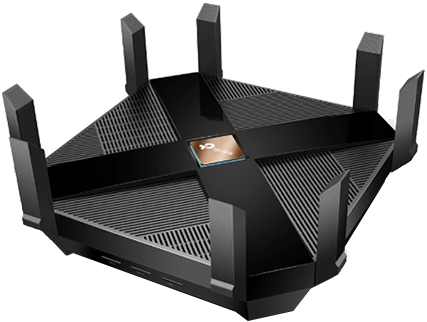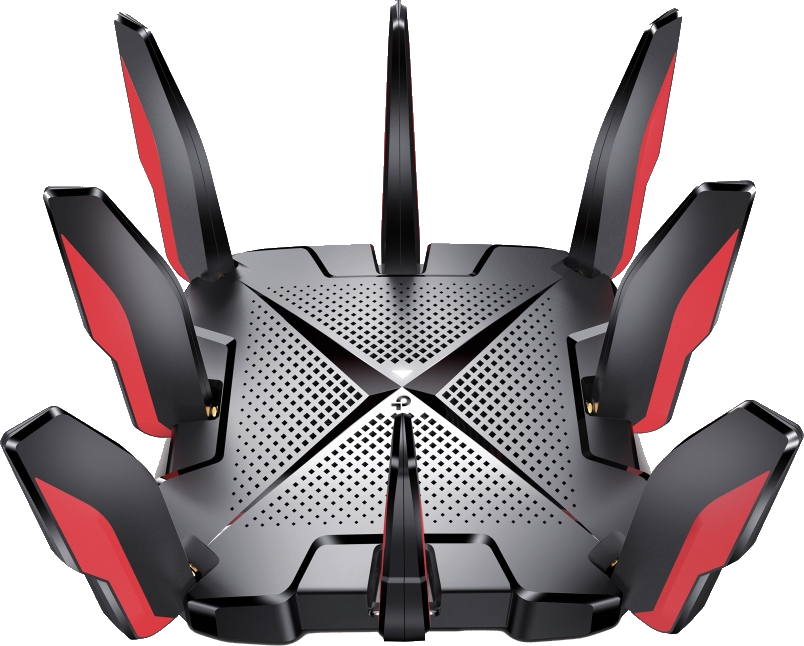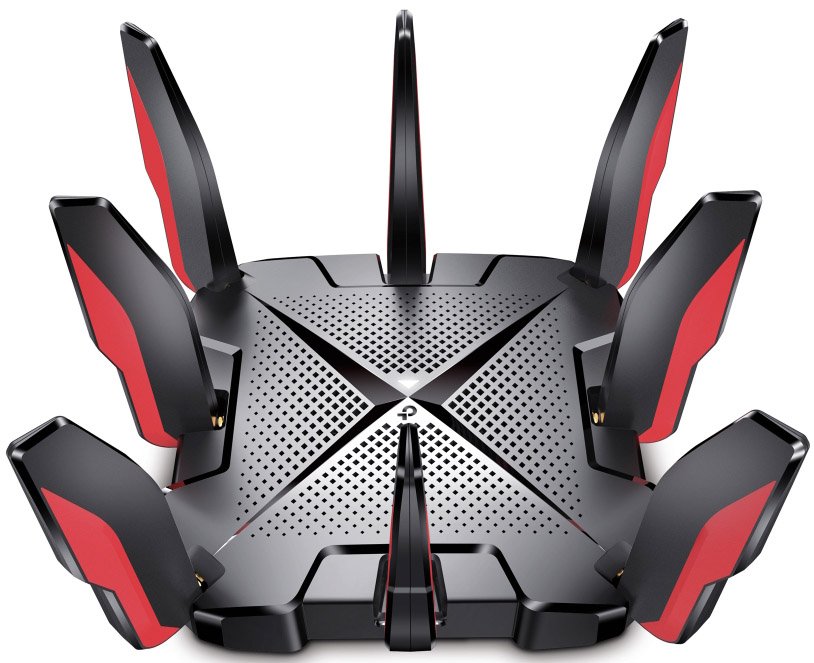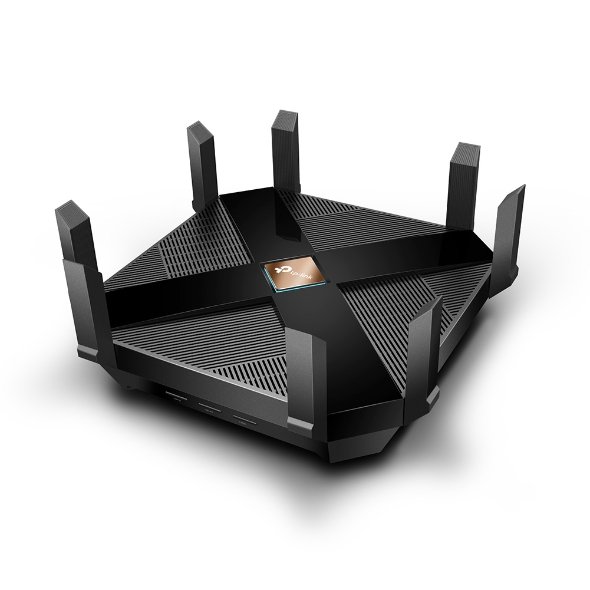TP-Link Archer AX6000 vs. GX90: Which should you buy?
Packed with ports
TP-Link Archer AX6000

Gaming-grade speed
TP-Link Archer GX90

Ultra-capable for handling multiple devices, the Archer AX6000 features eight LAN ports offering Gigabit speeds and the latest Wi-Fi 6 standard for wireless, so data transfer is blisteringly fast. The downsides come up with its loftier price and physical dimensions, taking up a lot of real estate on a table or desk.
$270 at Amazon
Pros
- Powerful one.8GHz 64-chip quad-core CPU
- Viii Gigabit LAN ports for wired devices
- USB-C port for modern expanded storage
Cons
- Expensive
- Physically gigantic
- Dual-ring Wi-Fi
Designed with gaming and network direction in listen, the Archer GX90 uses a defended 5GHz ring to reduce wireless traffic congestion. The game-axial features are not bad for monitoring latency but won't appeal to all users. Slightly smaller than its AX6000 counterpart, the GX90 is still hefty with fewer LAN ports.
$250 at Amazon
Pros
- Tri-band Wi-Fi
- Actress guest networks
- Game accelerator QoS
Cons
- Expensive
- Niche gaming tools
- Fewer high-speed LAN ports
The Archer AX6000 and GX90 are the latest Wi-Fi 6 routers from TP-Link and aren't so far apart in toll. Their similarity is no coincidence since the Archer GX90 uses the model number AX6600, meaning both are from the same generation of TP-Link routers. Breaking the hardware down into specifics reveals how close they are, with a small selection of central differences. So with both routers existence so closely related, which one should you buy?
Archer AX6000 vs. GX90: What's the departure?
These similarly chunky routers serve you loftier-speed internet with land-of-the-art wireless engineering. The Archer AX6000 and the GX90 make suitable impressions with their characteristic sets, and anyone purchasing either model would savor the benefits. A few additions on each side will tip the conclusion on which 1 you lot purchase based on your networking needs.
| Archer AX6000 | Archer GX90 | |
|---|---|---|
| Bands | 5GHz @ 4804 Mbps 2.4GHz @ 1148 Mbps | 5GHz @ 4804 Mbps 5GHz @ 1201 Mbps 2.4GHz @ 574 Mbps |
| Range | viii× fixed loftier-functioning antennas Beamforming High-power FEM 4T4R | 8× detachable loftier-functioning antennas Beamforming Loftier-ability FEM 4T4R |
| Guest networks | 1x 5GHz invitee network 1x 2.4GHz guest network | 2x 5GHz invitee networks 1x 2.4GHz guest network |
| CPU | 1.8GHz quad-core | 1.5GHz quad-core |
| LAN | 1x 2.5Gbps WAN port 8x Gigabit LAN ports | 1x 2.5Gbps WAN/LAN port 1x Gigabit WAN/LAN port 3x Gigabit LAN ports |
| USB | 1x USB-C three.0 port 1x USB-A 3.0 port | 1x USB iii.0 port 1x USB ii.0 port |
| Supported functions | Apple Time Machine FTP server Media server Samba server | Apple Fourth dimension Car FTP server Media server Samba server |
| Security | WPA WPA2 WPA3 | WPA WPA2 WPA3 WPA/WPA2-Enterprise (802.1x) |
| QoS | QoS by device HomeCare QoS by app | Game Accelerator QoS QoS past device HomeCare QoS by app |
| Ability | 12V = 4A | 12V = 5A |
| Dimensions | ten.3 × x.3 × 2.four inches (261.2 × 261.ii × lx.2 mm) | 8.3 × viii.iii × 2.0 inches (212 × 212 × 51.viii mm) |
Both models share the same Wi-Fi 6 standard, designed to connect more than devices simultaneously than ever. Since the AX6000 is the more expensive model, boasting a slightly faster CPU makes sense. Since both are quad-core processors, though, the functioning difference is negligible.
TP-Link's Game Accelerator technology on the Archer GX90 reduces latency and boosts game speed. Automatically detecting and optimizing gaming traffic helps to strengthen lag-free online multiplayer. Gamers volition appreciate the real-time statistics, but they are for more than just gaming. A real-time breakdown of data and bandwidth per device provided by Game Accelerator is merely plain useful for network troubleshooting.
Both routers offer 2 USB iii.0 and 2.0 ports for expansion, connecting printers, expanded storage, and more. The Archer AX6000 sports a USB-C three.0 port that supports modern network-attached storage (NAS) devices. The Archer GX90 withal offers USB three.0 speeds with an older USB-A style cablevision, though both routers tin use the USB functions supported by TP-Link, such every bit media servers.
Slightly fewer LAN ports on the GX90 could prove troublesome for anyone with more than than v wired devices, but connecting an extra network switch would solve this trouble without breaking the bank. The critical difference betwixt the two routers is the actress 5GHz network boasted by the tri-band GX90, but is tri-band that large of a deal?
Archer AX6000 vs. Archer GX90: Dual-band or tri-band?
 Source: Windows Central
Source: Windows Central
The advantage of tri-ring Wi-Fi is that it features an extra 5GHz band for handling access points and cyberspace traffic. Reducing network congestion is a benefit of the extra 5GHz band, and it offers upwardly an additional invitee network to keep visiting device traffic separate from your ain. That'due south non to say that dual-ring Wi-Fi is a slouch for wireless connectivity, and Wi-Fi six routers with a single 5GHz band will be perfectly suitable for most cases.
The addition of tri-band Wi-Fi commonly means sky-high prices over dual-band counterparts, so it'southward oft not worth forking out the extra cash for hereafter-proof engineering science that you might not apply. In the case of deciding which one you should buy, the tri-band GX90 is the cheaper choice, so it'south a much easier decision.
Archer AX6000 vs. GX90: Which should you lot buy?
The Archer GX90 is slightly cheaper than the AX6000 but much better value for money. If yous're in the market place for a Wi-Fi six router, don't exist turned off past the GX90 if you're not into gaming. Its network management and monitoring tools are applied for more than than only reducing lag, and the reward of tri-band Wi-Fi volition run into you into the future further than its chunkier counterpart, the AX6000.
If you prefer Gigabit speeds with wired devices and are unlikely to exceed internet speeds offered by dual-band Wi-Fi, then the Archer AX6000 is a respected option. The double helping of USB 3.0 ports would make for a formidable media center, feeding ultra-Hd content beyond your network with ease if you don't mind a trivial less desk space.
Gaming and beyond

TP-Link Archer GX90
Speed boosts and handy tools make the GX90 the clear selection.
With the latest Wi-Fi tech and options for expansion, the Archer GX90 is all the same pricey merely provides a lot of worth for the money over its bigger brother.
All wired up

TP-Link AX6000
A plethora of ports for wired devices and the latest Wi-Fi tech.
A powerful 64-fleck CPU and a gigantic offering of LAN ports make this the dual-band router of option if you have multiple wired devices. The addition of a USB-C port is perfect for modern network-attached storage (NAS) and would brand for a powerful media server.
We may earn a commission for purchases using our links. Learn more.

Xfinity and beyond
Enjoy Xfinity broadband without hardware rental fees
Xfinity cable broadband is super fast, merely the $xiv monthly fee for renting their router is steep. These combination modem routers are uniform with Xfinity net and will save you lot money in the long run.

Capture the lag
Play lag-free with the best routers for gaming
Gaming routers keep your network free of congestion and your latency super low, critical for those intense online matches. Our collection of the best routers for gaming volition fit your budget and keep you in the game.

What a mesh
Connect your home to the best mesh Wi-Fi router system
For home networking, mesh Wi-Fi systems provide more reliable coverage than a unmarried router. Check out our option of the all-time mesh Wi-Fi router systems to ensure y'all never bargain with point dead spots again.
Source: https://www.windowscentral.com/tp-link-archer-ax6000-vs-gx90
Posted by: jordanfriess50.blogspot.com


0 Response to "TP-Link Archer AX6000 vs. GX90: Which should you buy?"
Post a Comment